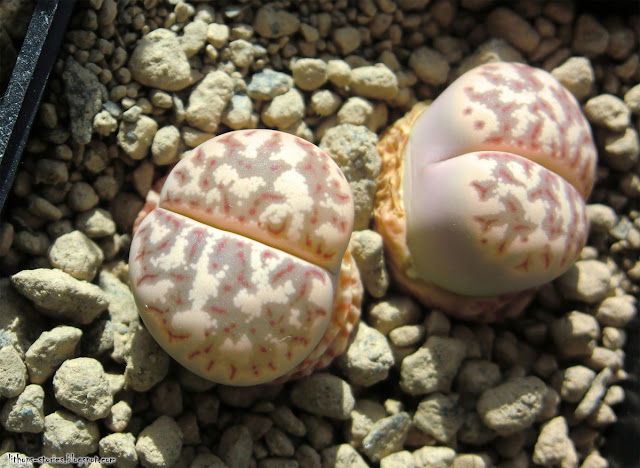One of the most common questions I am asked is about the size of my lithops plants and pots. While the part about pots is easily answered - 5 x 5 cm and 8,5 cm deep - it doesn't exactly clarify how big the plants are. I'm always writing about "the smaller the better" under windowsill conditions but how small is "small" exactly?
After having grown lithops for 10 years it is very clear that in order to grow them successfully under my conditions they absolutely need to be small. If watered (or fed) slightly too much they will stretch into unhealthy shapes and choke on their leaves during regeneration. If a plant is grown from seed by me it will increase in size extremely slowly. If I buy a large adult plant it will reduce its size at least by half during the next 1 or 2 leaf changes and stay like this (unless it dies). To get to the exact size of the plants I grow, imagine a 5x5cm pot and then imagine 8 adult plants growing in it. Or let's say rather 4 two-headed plants which would be more accurate. That's the limit that works for me without them squeezing each other out of the pot. It doesn't mean I follow through with it though. Sometimes I don't want to mix different species in one pot. Sometimes a plant looks great when it's presented individually. They do grow better I believe when potted in clusters but that's a story for another time.
According to various sources, L. aucampiae, L. pseudotruncatella, L. gracilidelineata and maybe L. hookeri belong to the larger species. And I'm talking about size of an individual head, not the ability to branch out. Let's see how this holds up on the windowsill.
I will measure the heads across the longest side. It will represent the plant size as of today, during active growth and regular water intake, not directly after regeneration when they are the smallest. I believe this is the average value even though they might increase in size a little bit until Fall (1-2 mm max).
The largest plants I have are Lithops gesinae v. annae (C078). They reach 2.2 cm consistently every year without any trouble regenerating and without any fertilizer or excessive watering. I've grown them for several years and it's always the same. I'd actually recommend them for beginners. My first plant came in 2008 when lithops were fairly new to me.
This below plant is two-headed and each head measures 2.2 cm.
As a contrast to that, L. gesinae v. gesinae (C207) are really small. The larger plant's head size is 1.3 cm while the smaller is 0.9 cm. It also seems to be a fixed value every year. They don't get bigger at all and are slow to regenerate.
L. aucampiae are considered large but on my windowsill they are no bigger than the regular L. lesliei (in fact some of my L. lesliei are larger than L. aucampiae). The largest plant I have is this L. aucampiae sp. at 1.9 cm. I got it from a gardening store rather bloated but it came back to this size after a couple of leaf changes and it works for it.
L. aucampiae 'Storm's Snowcap' (C392) plants I got from a specialized grower a couple of years ago measure 1.4 cm per head, which is the same size as my own 5 year old seedlings of L. aucampiae ssp. aucampiae v. aucampiae 'White Flower' (C002A). 1.4 cm is also the size of my L. aucampiae ssp. euniceae v. fluminalis (C054)
Let's check L. gracilidelineata. My mixed seedlings are from 2009 so you can say they are of adult size. I have 3 larger plants and 3 smaller. The larger plants measure 1.8 cm.
The smaller specimen are 1.4 cm.
Moving on to L. dorotheae, as they seem to be quite large. All the below are 1.7 cm
L. dorotheae de Boer
L. dorotheae (C300)
This L. dorotheae (C300) however is slightly smaller, measuring 1.5 cm across. It compensates with its 3 heads I guess.
I only have one L. olivacea v. olivacea (C055) so it's not exactly representative. The head size per se is not very large but this two-headed plant is massive all in all and occupies one pot by itself. Same as L. gesinae v. annae, it regenerates into the same size every year and maintains it without any help. The head size is 1.7 cm.
To sum things up, it seems that the average head size of larger specimen of lithops on the windowsill is around 1.7 cm. I will continue this topic and review the smaller plants next time.


















what is the name of the smoothvgreen lithops species shown in the very last image?
ReplyDeleteAs it says in the text, it's L. olivacea v. olivacea (C055)
Delete